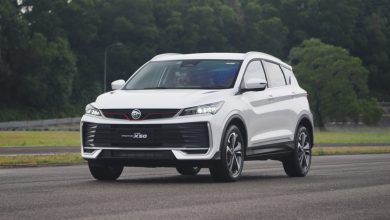Mercedes-Benz EQB Is An All-Electric Version Of Its GLB
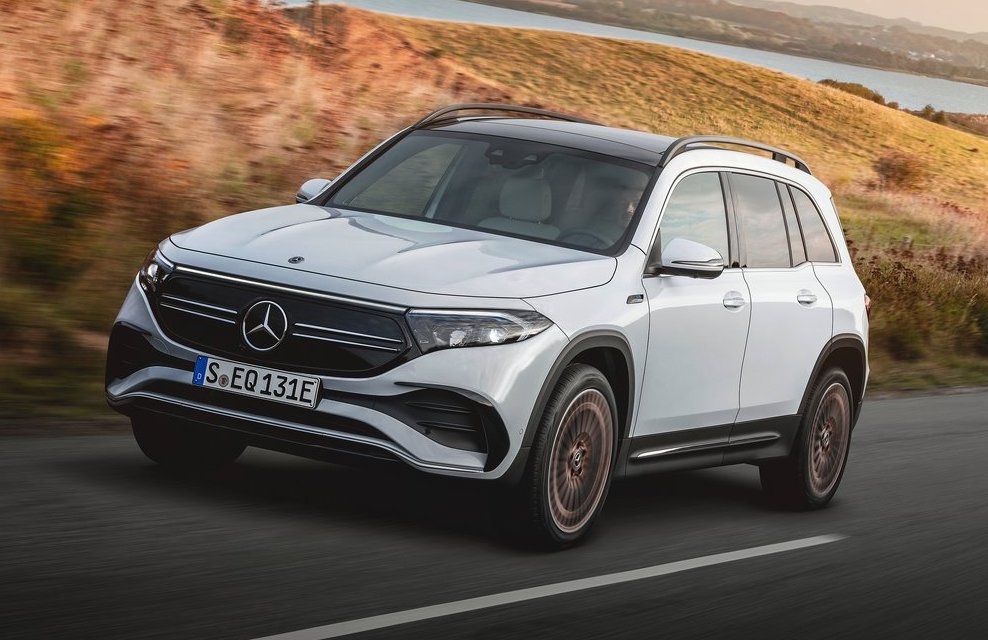
The seven seats of the GLB still remains in the new EQB e-SUV, but only just.
Following on from the recent launch of the all-new, all-electric EQS flagship sedan, Mercedes-Benz has since unveiled a more affordable, and slightly more practical EV in the form of the new EQB.
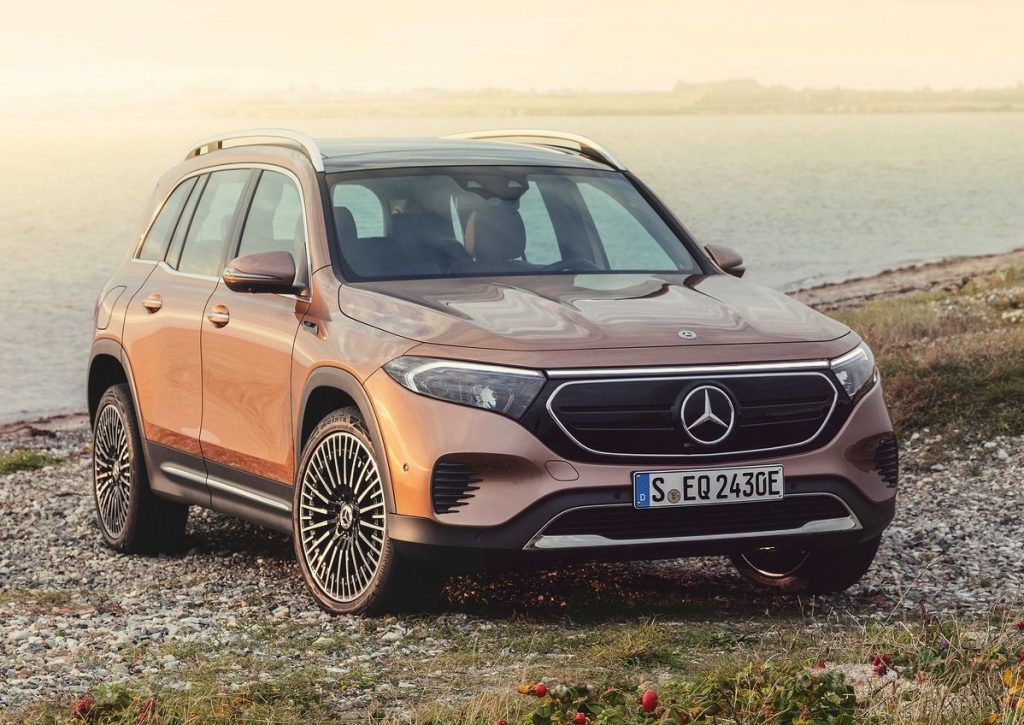
Recently previewed at the ongoing Shanghai Auto Show, this new all-electric SUV follows much the same working principle as the GLA-based EQA compact crossover revealed some time ago. That being stuffing a zero-emissions heart into a car that was once meant to feature an internal combustion engine, instead of building an all-new car from the ground up alá EQS.
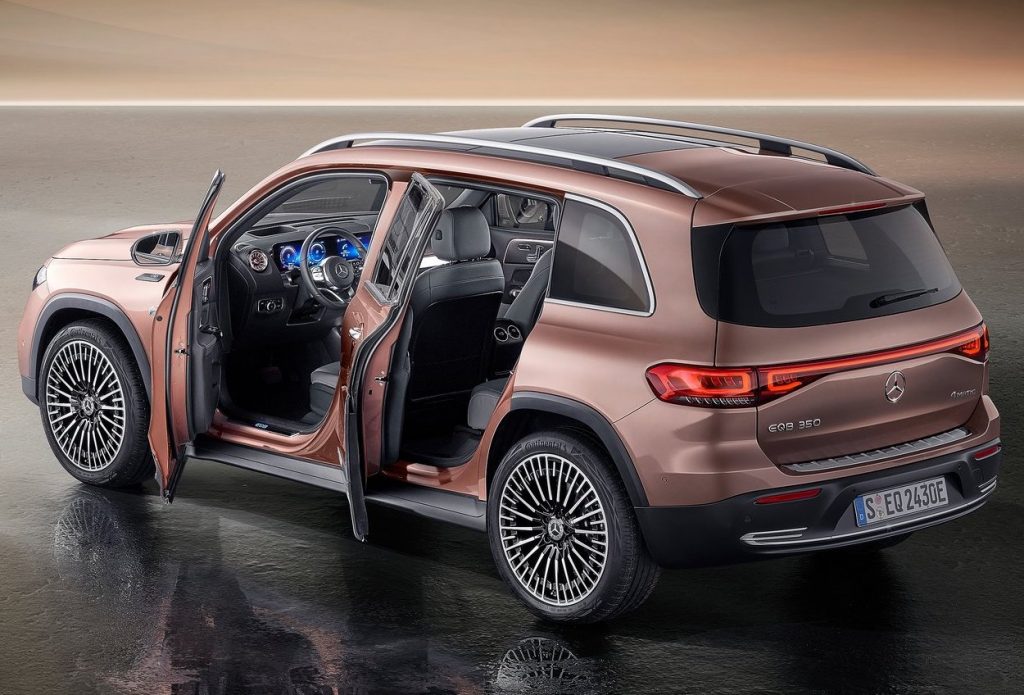
This methodology however proves to have had a few hiccups for the EQB, as its bulky batteries situated beneath the floor does further eat up into the original GLB’s already compact interior volume. Meaning that this all-electric compact crossover now can only supposedly squeeze occupants with a height of up to 1.65 m in its (optional) third row of seats, as well as losing roughly 75 litres of usable boot space as compared to its piston-powered counterparts.

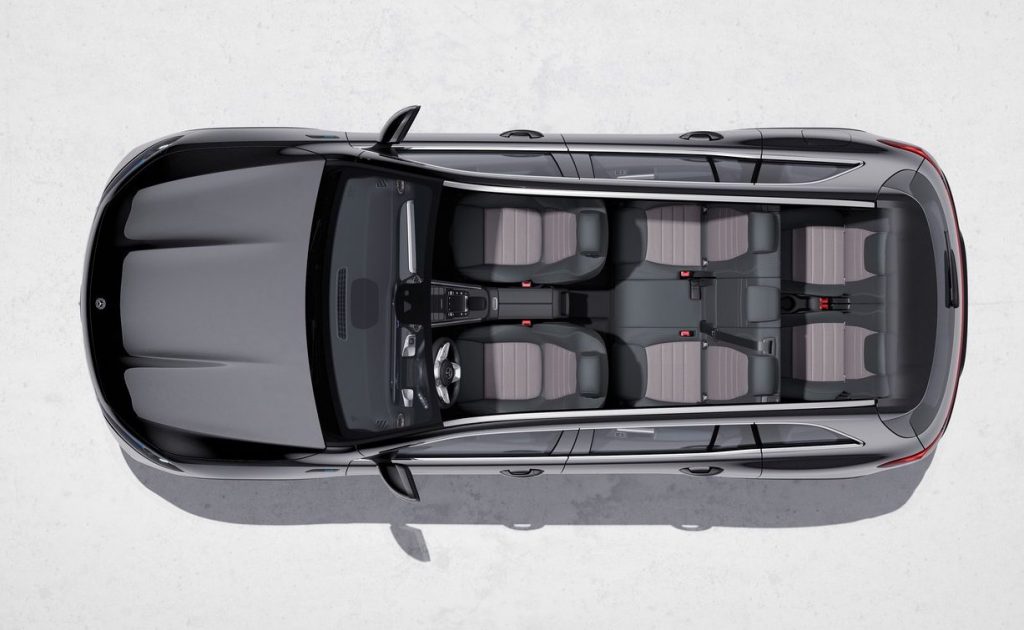
Practicality issues aside however, the rest of the interior of this EQB is much the same as the GLB on which it is based. There are nevertheless some electric-only add ons to highlight here, such as the standard Navigation with Electric Intelligence functionality on the twin-screen MBUX infotainment system, as well as a new optional rose gold hue (the signature colour for the EQ range of Benzes) for various interior accents like the air vents and the dashboard fascia.
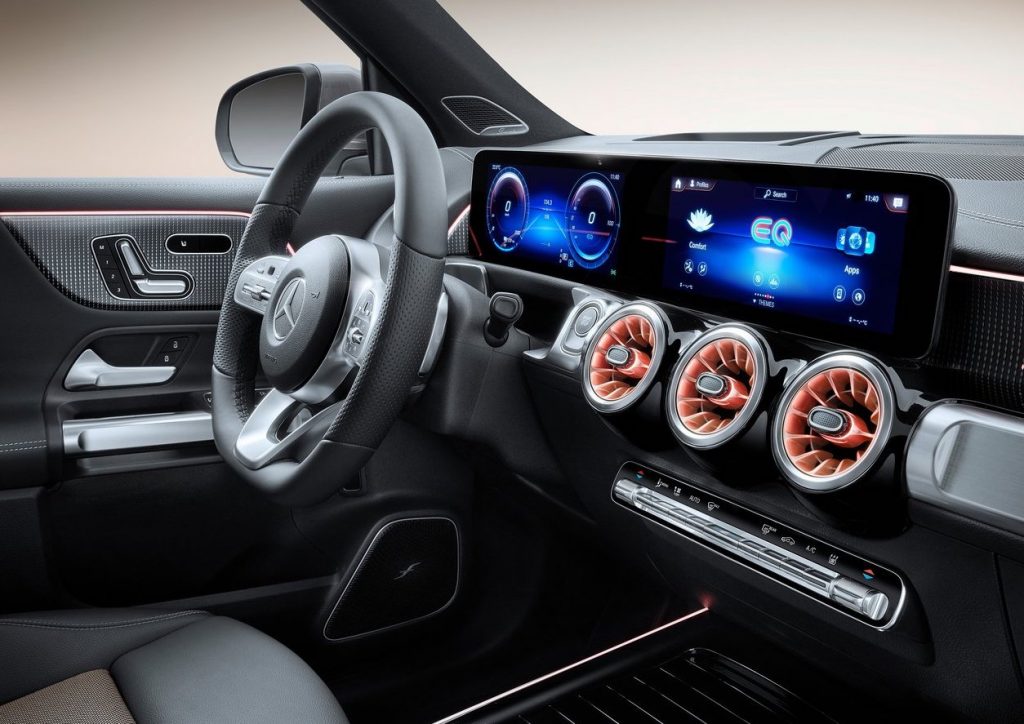
Moving outside and discussing the exterior aesthetics of the EQB, this boxy all-electric Benz gains curvier silhouette from its combustion-engined counterparts courtesy of rounder bumpers on the front and rear. An EQC-esque blanked off black grille up front with a light bar that features a continuous continuous fibre-optic light strip to the LED headlights on either side are also among the design distinctions on the outside this e-SUV, as are full-width LED rear light bar and alloy wheels of up to 20-inches in diameter that come with the option of a rose gold or blue finish.


As for what turns those wheels, the exact powertrain details regarding this EQB are still unknown at the moment. What has come to light though is that there will be single (front wheel drive) and dual-motored (all-wheel drive) variants to be available, with power outputs ranging from between 190 hp and 280 hp for the base EQB250 and the top-of-the-range EQB350 4Matic respectively.
Feeding these motors meanwhile will be the responsibility of lithium ion battery pack that ranges from 66.5 kWh in capacity. Supposedly good for a driving range of 420 km on a single charge, there is also apparently to be an extra long range variant of the EQB to be launched sometime down the line.
Speaking of the future, the all-electric EQB is set to arrive first in Chinese and European Mercedes-Benz showrooms by the end of this year. Its North American launch on the other hand is set to only take place early next year, with its arrival in other markets presumably to follow on from that.

PRESS RELEASE: Whether a large nuclear family or a small extended family: as a seven-seater, the new EQB offers space for many family constellations and a wide variety of transport needs. This gives it an exceptional position not only in the compact segment, but especially among electric cars. The two seats in the third row can be used by people up to 1.65 metres tall, and child seats can also be fitted there. The new EQB made its debut at Auto Shanghai 2021. Following the EQA 250 it is the second fully electric compact car from Mercedes-EQ. The powerful and efficient electric drive, clever recuperation and predictive Navigation with Electric Intelligence are just some of the features that link it to the EQA. The market launch in China is scheduled for 2021. After Europe, the international version of the EQB, produced in Kecskemét, Hungary, will be launched at the end of 2021, followed by the US market launch in 2022.
The electric offensive from Mercedes-Benz Cars is not only picking up speed, it is accelerating with as much kick as the Mercedes-EQ vehicles themselves: while the first EQAs roll into European dealerships and the EQS, the purpose-designed, all-electric member of the new S-Class family, is being presented, the version of the new EQB specific to China will be making its debut in Shanghai at the same time. It is also produced in China at Beijing Benz Automotive Co., Ltd (BBAC), a joint venture between Daimler and its Chinese partner BAIC Group. The design of the new all-electric compact SUV interprets the progressive luxury of Mercedes-EQ in an edgy and characterful way.
In China, the new EQB is being launched as a fully equipped top-of-the-range model with AMG Line and an output of 215 kW. In Europe, right from the start customers will have the choice between several models with front-wheel and all-wheel drive and various power levels, some rated at over 200 kW. The usable capacity of the batteries in Europe is 66.5 kWh. These batteries are manufactured at the Daimler plants in Kamenz (Germany) and Jawor (Poland). A particularly long-range version is also planned. The electrical consumption of the EQB 350 4MATIC in Europe, NEDC: combined electrical consumption: 16.2 kWh/100 km; combined CO2 emissions: 0 g/km, range 478 km; WLTP: combined electrical consumption: 19.2-18.1 kWh/100 km; combined CO2 emissions: 0 g/km, range 419 km.
In 2021, Mercedes-Benz Cars is pushing ahead rapidly with electrification. With the EQA, the EQB, the electric business saloon EQE and the EQS, a total of four new models from Mercedes-EQ will be presented. The Mercedes-Benz plug-in hybrid family, currently consisting of more than 20 model variants, is being renewed with electrified derivatives of the C-Class and the S-Class. For 2021, Mercedes-Benz Cars expects to increase the xEV share, i.e. of plug-in hybrids and fully electric vehicles, to around 13 percent. In addition, mild hybrids with starter-alternator and 48-volt system are conquering the product range, especially of the group’s luxury vehicles.

Generous space and variable, level boot
The new EQB (length/width/height: 4684/1834/1667 millimetres) enriches Mercedes’ successful compact car family and is closely related to two models in particular: to the EQA, whose advanced drive technology it shares, and to the GLB compact SUV. This is where the long wheelbase (2829 millimetres), the spacious and variable interior and the third row of seats with two additional individual seats come from.
The amount of space is generous: the headroom in the first row of seats is 1035 millimetres, in the second it is 979 millimetres for the five-seater. With 87 millimetres, the knee space in the rear of the five-seater reaches a comfortable level. The boot is level and spacious: The load volume of 495 to 1710 or 465 to 1620 litres (figures for five- and seven-seaters respectively) has the qualities of a compact estate car. The inclination of the backrests in the second row can be adjusted in several stages as standard, and as an option it features longitudinally adjustment of 140 millimetres. This enables the boot to be enlarged by up to 190 litres and put to versatile use.
As an option (standard in China), the EQB has a third row of seats with two additional individual seats. The seats offer people up to a height of 1.65 metres a comfortable amount of space. Extensive safety features include extractable head restraints, seat belts with belt tensioners and force limiters on all outer seats and a side windowbag that also covers passengers in the third row. A total of up to four child seats can be fitted in rows two and three, plus one more in the front passenger seat. To increase luggage space, the third row seats can be lowered flush into the load floor.

Electro design aesthetics with corners and edges
The EQB interprets Mercedes-EQ’s Progressive Luxury in an edgy and characterful way. It features the typical Mercedes-EQ black panel grille with central star. A further distinctive design feature of the all-electric world of Mercedes-EQ vehicles is the continuous light strip at front and rear. A horizontal fibre-optic strip connects the daytime running lights of the full-LED headlamps, ensuring a high level of recognisability both in daylight and at night. The inside of the headlamps is finished to a high level of quality, detail and precision. Blue colour highlights within the headlamp reinforce the signature Mercedes-EQ appearance.
The function-oriented greenhouse with upright windscreen makes the comfortable interior possible. Circumferential and protective cladding elements structure the overall proportion. The muscular and sensuously modelled vehicle shoulder dominates the side view, which is further enhanced by the rise of the beltline. Outwardly positioned wheels give the EQB a powerful character and confident stance on the road. Exclusive to this model are light-alloy wheels in a bi- or tri-colour design, up to 20 inches in size, in some cases with rosé gold-coloured or blue decorative trim.
The LED tail lamps merge seamlessly into the tapered LED light strip. This underlines the horizontal sense of width of the EQB in the rear view. In addition, the number plate is placed on the bumper, which allows for a beautifully sculpted tailgate. The studded roof rails underline the high utility value of the new EQB.
The large body of the dashboard has a cut-out in the driver and passenger area. The driver faces a Widescreen Cockpit, with control and display via MBUX (Mercedes-Benz User Experience). The robust character of the interior is underlined by tubular elements in an aluminium look. They sit as handles in the doors, in the centre console and in the instrument panel on the passenger side.
Depending on the design and equipment line, a spectacular backlit trim piece and rosé gold-coloured decorative elements on the air vents, seats and vehicle key provide clues to the electric character in the interior of the EQB. The instruments, with their electric car-specific displays, pick up on the same colour scheme with rosé gold-coloured and blue highlights.
The EQB achieves a very good drag value with a Cd value from 0.28. The frontal area A totals 2.53 m2. Among the most important aerodynamic measures are the completely closed cooling air control system in the upper section, the aerodynamically efficient front and rear aprons, a very smooth, almost completely enclosed underbody, specially optimised Aero wheels and specifically adapted front and rear wheel spoilers.

Efficient driving pleasure and Navigation with Electric Intelligence
ECO Assist offers a recuperation process optimised to the particular situation. It incorporates navigation data, traffic sign recognition and information from the vehicle sensors into its efficiency strategy. Anticipatory driving saves power, thereby extending the range.
The standard Navigation with Electric Intelligence also contributes to the effortless handling of the EQB in everyday life. It calculates the fastest route to the destination, including any necessary charging stops. On the basis of continual range simulations, the system makes allowance for any necessary charging stops as well as for numerous other factors, such as the topography and the weather. It is also able to react dynamically to changes, for instance in the traffic situation or personal driving style. In addition, the Navigation with Electric Intelligence ensures that the high-voltage battery is brought to an optimal charging temperature before a planned charging stop, if needed.
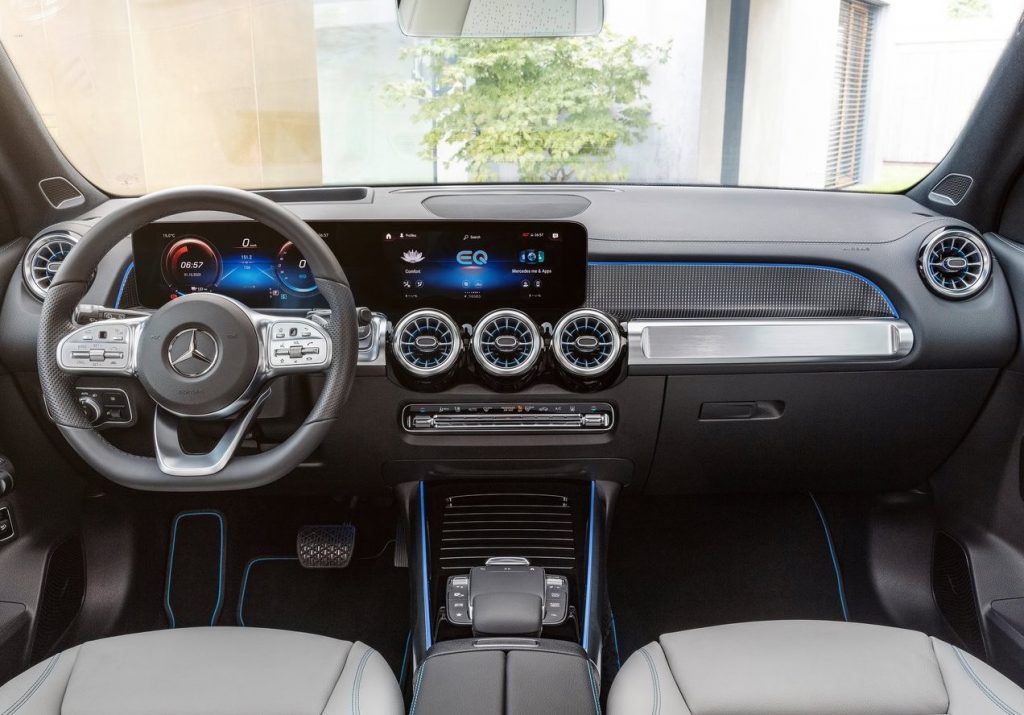
Sophisticated charging technology, large network and green power
At home or at public charging stations, the EQB can be conveniently charged at up to 11 kW with alternating current (AC) using the onboard charger. The charging time required for a full charge depends on the available infrastructure and the country-specific vehicle equipment. Charging at a Mercedes-Benz Wallbox is considerably faster than at a household socket.
And it is of course even faster at direct current (DC) fast-charging stations. Depending on the SoC (State of Charge) and the temperature of the high-voltage battery, the EQB charges at a corresponding charging station with a maximum power of up to 100 kW. The charging time is then just over 30 minutes from 10-80 percent SoC. For AC and DC charging, the EQB is equipped as standard in Europe and the USA with a CCS (Combined Charging Systems) connector in the right-hand side panel. In China, a country-specific charging solution with sockets on the right and left in the side wall is used, and charging times may also vary compared with the European version.
Via Mercedes me Charge, EQB drivers will be able to use what is currently the largest charging network in the world: this currently comprises more than 500,000 AC and DC charging stations across 31 countries. Mercedes me Charge allows Mercedes-EQ customers convenient use of the charging stations of various providers, while they also benefit from an integrated payment function with simple billing processes.
By means of high-quality certificates of origin, Mercedes-Benz guarantees that energy from renewable energy sources is fed into the grid for charging current sourced via Mercedes me Charge. With Mercedes me Charge, customers can charge at more than 200,000 public charging stations across Europe, where Mercedes-Benz ensures subsequent compensation through green electricity.

Cooperative support for the driver and high level of crash safety
The EQB features intelligent driving assistance systems with cooperative support for the driver. Active Lane Keeping Assist and Active Brake Assist are fitted as standard. In many critical situations, the latter has the ability to prevent a collision or reduce its severity with autonomous braking. The system is also able to brake for stationary vehicles and crossing pedestrians at typical city speeds. The enhanced functions of the Driving Assistance Package include, for example, the turning manoeuvre function, the emergency corridor function, the exit warning function alerting the driver to approaching cyclists or vehicles, and a warning when pedestrians are detected near zebra crossings.
The EQB is also a true Mercedes when it comes to passive safety. Building on the robust bodyshell structure of the GLB, the body of the EQB was adapted to the special requirements of an electric car. The battery sits within a frame made out of extruded sections. This takes on a structural function which until now was maintained by the cross members in the underfloor. A battery guard in the front area of the battery is able to prevent the energy storage unit from being pierced by foreign objects.
Of course, the EQB had to pass the brand’s usual extensive crash test programme. Stringent requirements for the battery and all components carrying electrical current also apply.

The EQB in the global production network
Production of the EQB will commence in 2021 at two sites forming part of the production network of Mercedes-Benz Cars: at the Hungarian Mercedes-Benz plant in Kecskemét for the global market and at the German-Chinese joint venture BBAC in Beijing for the local market. Preparations, including staff qualification processes and reconstruction work, have already commenced at the plants. The EQB compact SUV will be the first purely electrically powered production vehicle from Hungary and will supplement the plug-in hybrid portfolio which comprises the CLA and CLA Shooting Brake. The A-Class will also be produced with plug-in hybrid drive at Kecskemét in future as well as at the German Mercedes-Benz plant in Rastatt, where the EQA is built.
Since it commenced production in 2012, the Hungarian Mercedes-Benz plant has continually increased in importance within the global production network of Mercedes-Benz Cars. In addition to digital networking, the strengths of the compact car production network include direct exchange with the lead plant for compact cars in Rastatt, Baden-Württemberg.




